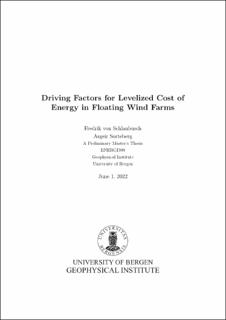| dc.description.abstract | This thesis presents a method for calculating LCOE for offshore floating wind farms. A method has been created that aims to do a life cycle cost analysis, with emphasis on the cost of installation and transportation, and the cost of operation and maintenance for. The method was created to carry out a sensitivity analysis on the effects of various wind farm parameters such as water depth, distance to harbor, wind farm lifetime, capacity factor, wake loss, and the number of wind turbines in the wind farm, on the LCOE of the wind farm. The method was also created to see differences in cost between the three floating platform types: Spar Buoy, Tension Leg Platform, and Semi-Submersible Platform. In 2010 NVE looked at the suitability of 15 locations outside the Norwegian cost for offshore wind farms, Espegren et al. (2010). Four of these locations had water depth suitable for floating platforms. In 2012 another report was published by NVE, looking at the economic suitability of wind farms in the 15 locations, Sydness et al. (2012). The data used in their report has not been made publicly available. In this thesis, data from the dataset NORA3, described by Solbrekke and Sorteberg (2021), has been used, together with a method for calculation of LCOE, to compare the economic potential with that found by NVE for the four locations suitable for floating wind farm, Utsira Nord, Stadthavet, Frøyabanken, and Træna Vest. The results presented in this thesis, points in the same direction as that found by NVE, with some variations. The results presented in this thesis shows the locations Utsira Nord, and Stadthavet as the most economically viable locations, with an LCOE about 15 to 20 e/MWh lower than that found for Frøyabnaken, and Træna Vest. The results of the sensitivity analysis shows that the capacity factor of a lo- cation should be a decisive factor when building a wind farm with low LOCE is the goal. Other factors such as being able to extend the lifetime of the wind farm, and keeping the distance from the wind farm to a port short, was also shown to have a significant effect on lowering the LCOE. The distance to harbor was found to have a great impact on LCOE for large distances. Out of the wind farm parameters investigated, water depth was found to have the least amount of impact on LCOE. | |
